radio Mercury Sable 2002 s User Guide
[x] Cancel search | Manufacturer: MERCURY, Model Year: 2002, Model line: Sable, Model: Mercury Sable 2002Pages: 240, PDF Size: 3.53 MB
Page 34 of 240
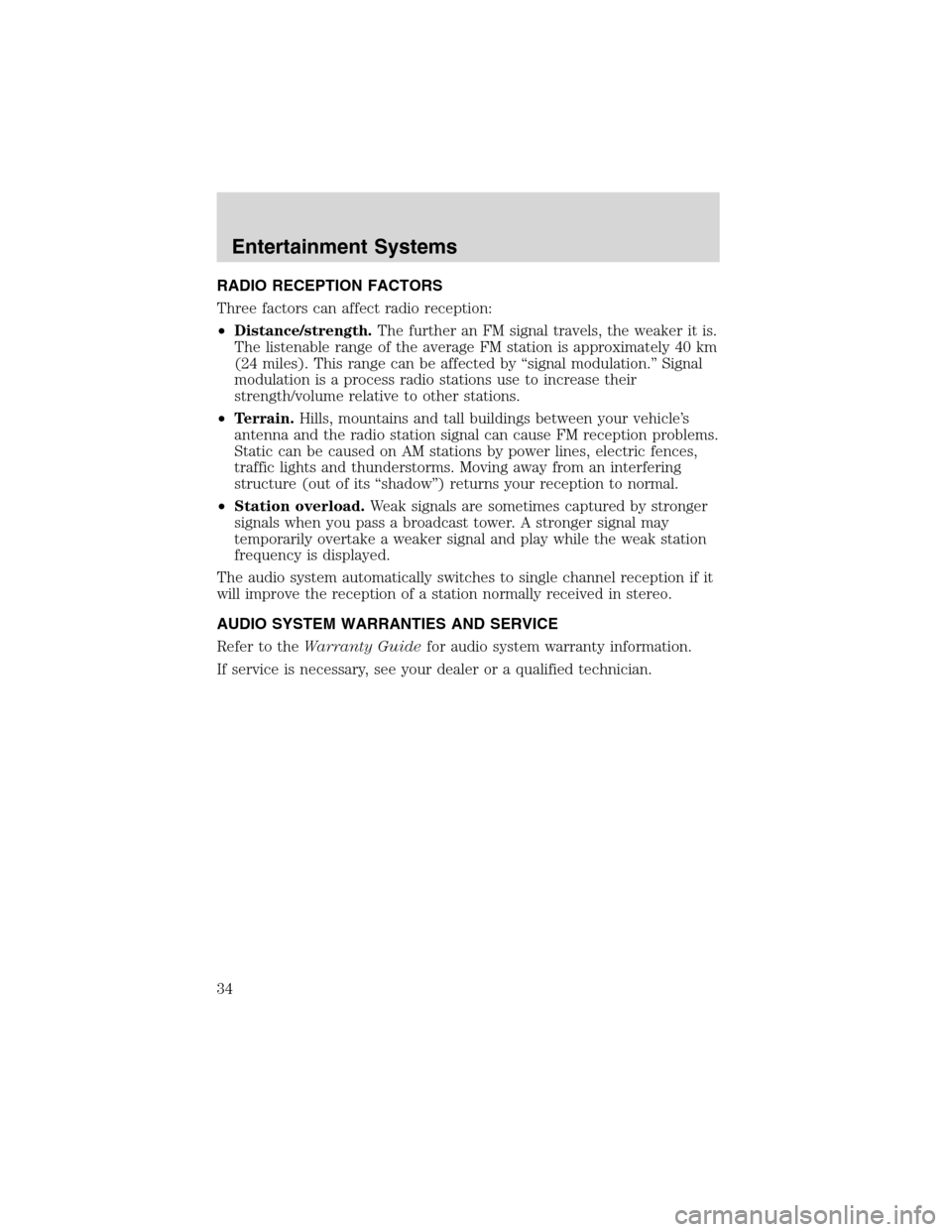
RADIO RECEPTION FACTORS
Three factors can affect radio reception:
•Distance/strength.The further an FM signal travels, the weaker it is.
The listenable range of the average FM station is approximately 40 km
(24 miles). This range can be affected by“signal modulation.”Signal
modulation is a process radio stations use to increase their
strength/volume relative to other stations.
•Terrain.Hills, mountains and tall buildings between your vehicle’s
antenna and the radio station signal can cause FM reception problems.
Static can be caused on AM stations by power lines, electric fences,
traffic lights and thunderstorms. Moving away from an interfering
structure (out of its“shadow”) returns your reception to normal.
•Station overload.Weak signals are sometimes captured by stronger
signals when you pass a broadcast tower. A stronger signal may
temporarily overtake a weaker signal and play while the weak station
frequency is displayed.
The audio system automatically switches to single channel reception if it
will improve the reception of a station normally received in stereo.
AUDIO SYSTEM WARRANTIES AND SERVICE
Refer to theWarranty Guidefor audio system warranty information.
If service is necessary, see your dealer or a qualified technician.
Entertainment Systems
34
Page 43 of 240
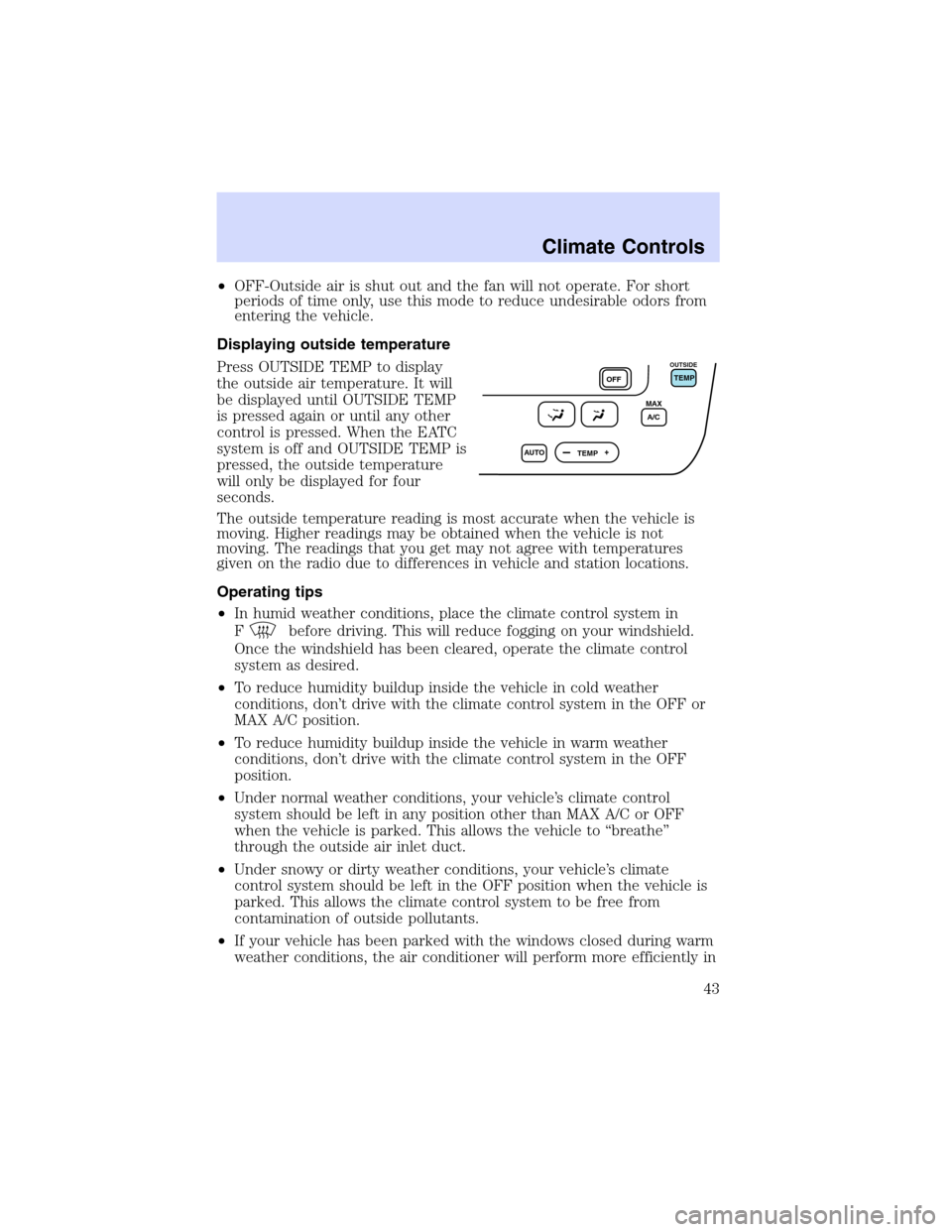
•OFF-Outside air is shut out and the fan will not operate. For short
periods of time only, use this mode to reduce undesirable odors from
entering the vehicle.
Displaying outside temperature
Press OUTSIDE TEMP to display
the outside air temperature. It will
be displayed until OUTSIDE TEMP
is pressed again or until any other
control is pressed. When the EATC
system is off and OUTSIDE TEMP is
pressed, the outside temperature
will only be displayed for four
seconds.
The outside temperature reading is most accurate when the vehicle is
moving. Higher readings may be obtained when the vehicle is not
moving. The readings that you get may not agree with temperatures
given on the radio due to differences in vehicle and station locations.
Operating tips
•In humid weather conditions, place the climate control system in
F
before driving. This will reduce fogging on your windshield.
Once the windshield has been cleared, operate the climate control
system as desired.
•To reduce humidity buildup inside the vehicle in cold weather
conditions, don’t drive with the climate control system in the OFF or
MAX A/C position.
•To reduce humidity buildup inside the vehicle in warm weather
conditions, don’t drive with the climate control system in the OFF
position.
•Under normal weather conditions, your vehicle’s climate control
system should be left in any position other than MAX A/C or OFF
when the vehicle is parked. This allows the vehicle to“breathe”
through the outside air inlet duct.
•Under snowy or dirty weather conditions, your vehicle’s climate
control system should be left in the OFF position when the vehicle is
parked. This allows the climate control system to be free from
contamination of outside pollutants.
•If your vehicle has been parked with the windows closed during warm
weather conditions, the air conditioner will perform more efficiently in
AUTO
TEMPOFFTEMP
MAX
A/C
OUTSIDE
Climate Controls
43
Page 74 of 240
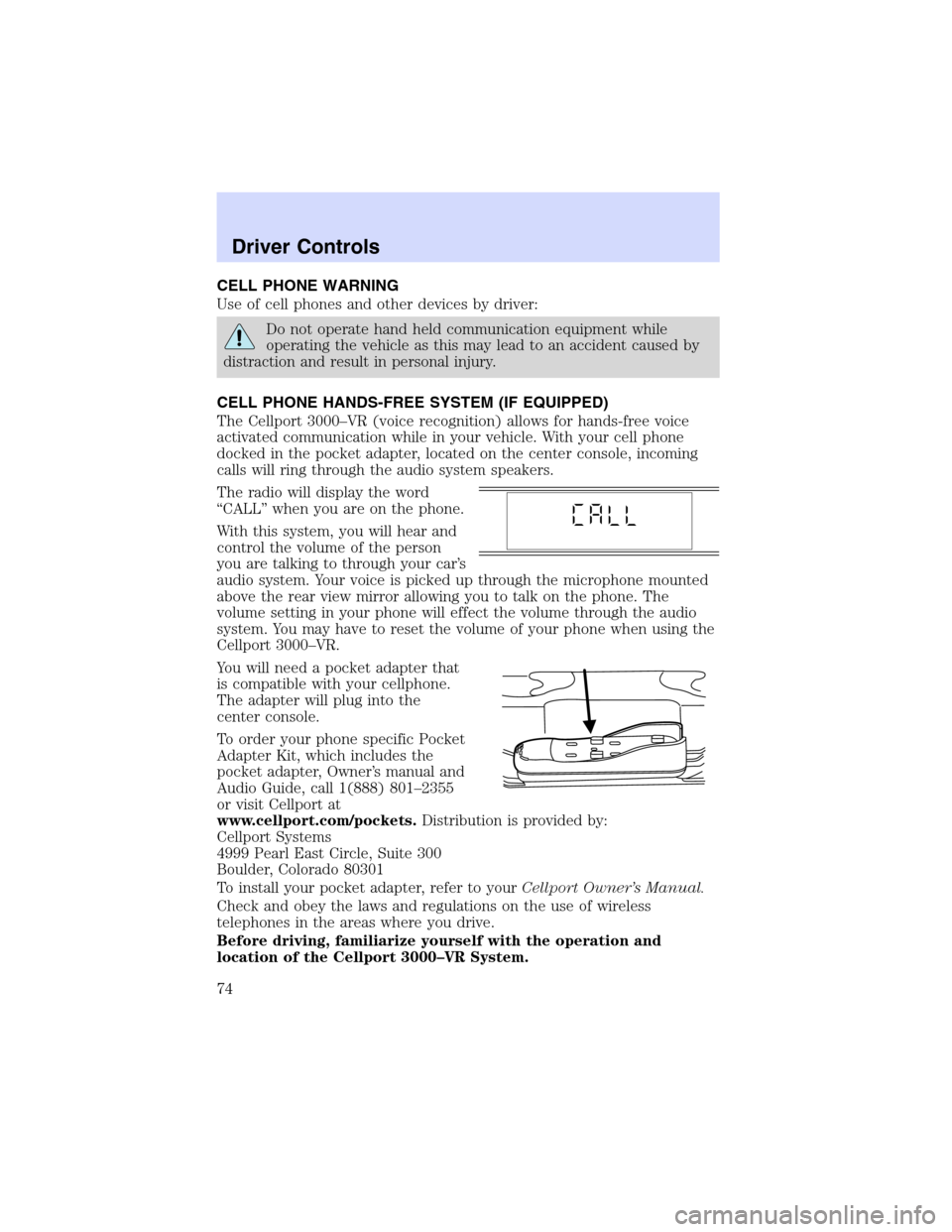
CELL PHONE WARNING
Use of cell phones and other devices by driver:
Do not operate hand held communication equipment while
operating the vehicle as this may lead to an accident caused by
distraction and result in personal injury.
CELL PHONE HANDS-FREE SYSTEM (IF EQUIPPED)
The Cellport 3000–VR (voice recognition) allows for hands-free voice
activated communication while in your vehicle. With your cell phone
docked in the pocket adapter, located on the center console, incoming
calls will ring through the audio system speakers.
The radio will display the word
“CALL”when you are on the phone.
With this system, you will hear and
control the volume of the person
you are talking to through your car’s
audio system. Your voice is picked up through the microphone mounted
above the rear view mirror allowing you to talk on the phone. The
volume setting in your phone will effect the volume through the audio
system. You may have to reset the volume of your phone when using the
Cellport 3000–VR.
You will need a pocket adapter that
is compatible with your cellphone.
The adapter will plug into the
center console.
To order your phone specific Pocket
Adapter Kit, which includes the
pocket adapter, Owner’s manual and
Audio Guide, call 1(888) 801–2355
or visit Cellport at
www.cellport.com/pockets.Distribution is provided by:
Cellport Systems
4999 Pearl East Circle, Suite 300
Boulder, Colorado 80301
To install your pocket adapter, refer to yourCellport Owner’s Manual.
Check and obey the laws and regulations on the use of wireless
telephones in the areas where you drive.
Before driving, familiarize yourself with the operation and
location of the Cellport 3000–VR System.
Driver Controls
74
Page 83 of 240
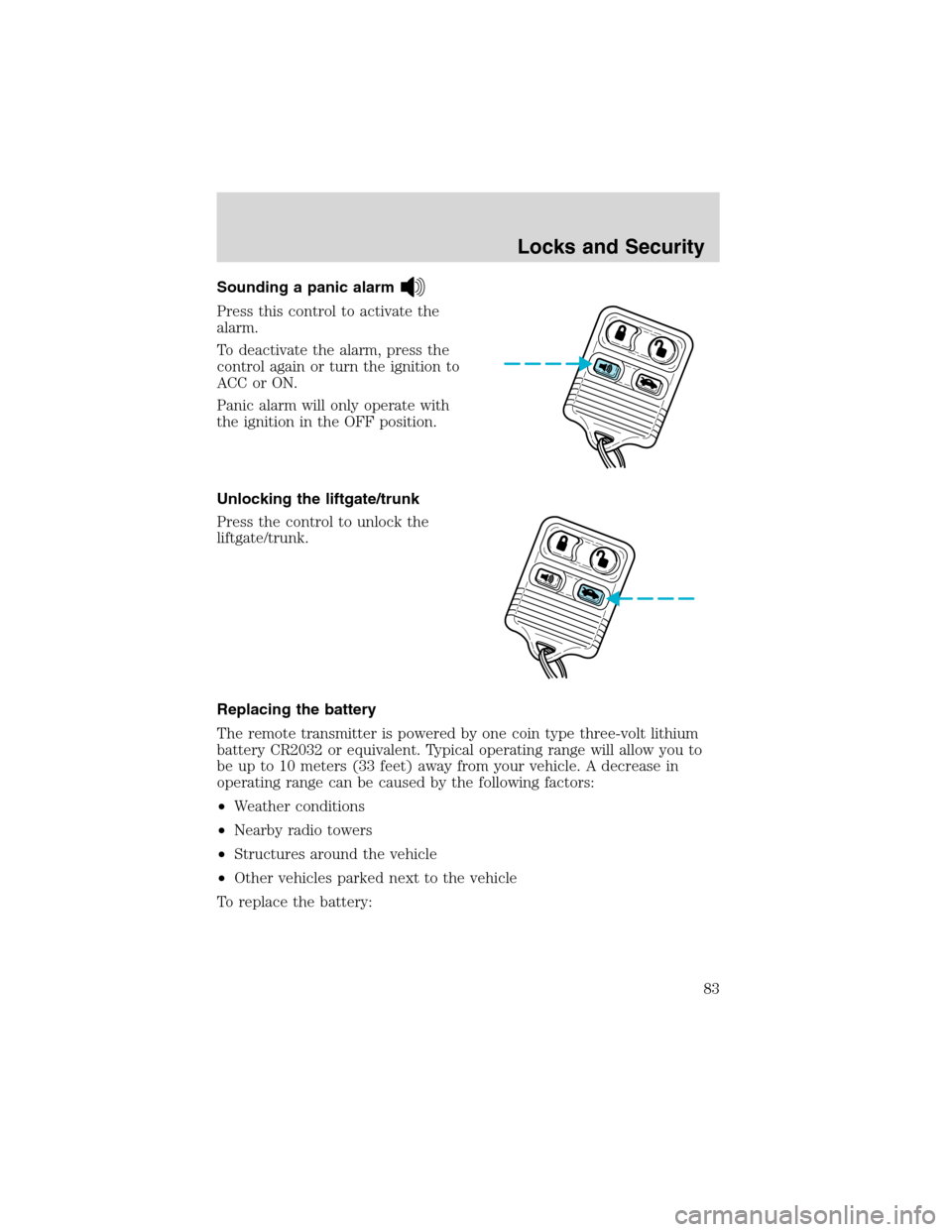
Sounding a panic alarm
Press this control to activate the
alarm.
To deactivate the alarm, press the
control again or turn the ignition to
ACC or ON.
Panic alarm will only operate with
the ignition in the OFF position.
Unlocking the liftgate/trunk
Press the control to unlock the
liftgate/trunk.
Replacing the battery
The remote transmitter is powered by one coin type three-volt lithium
battery CR2032 or equivalent. Typical operating range will allow you to
be up to 10 meters (33 feet) away from your vehicle. A decrease in
operating range can be caused by the following factors:
•Weather conditions
•Nearby radio towers
•Structures around the vehicle
•Other vehicles parked next to the vehicle
To replace the battery:
Locks and Security
83
Page 134 of 240
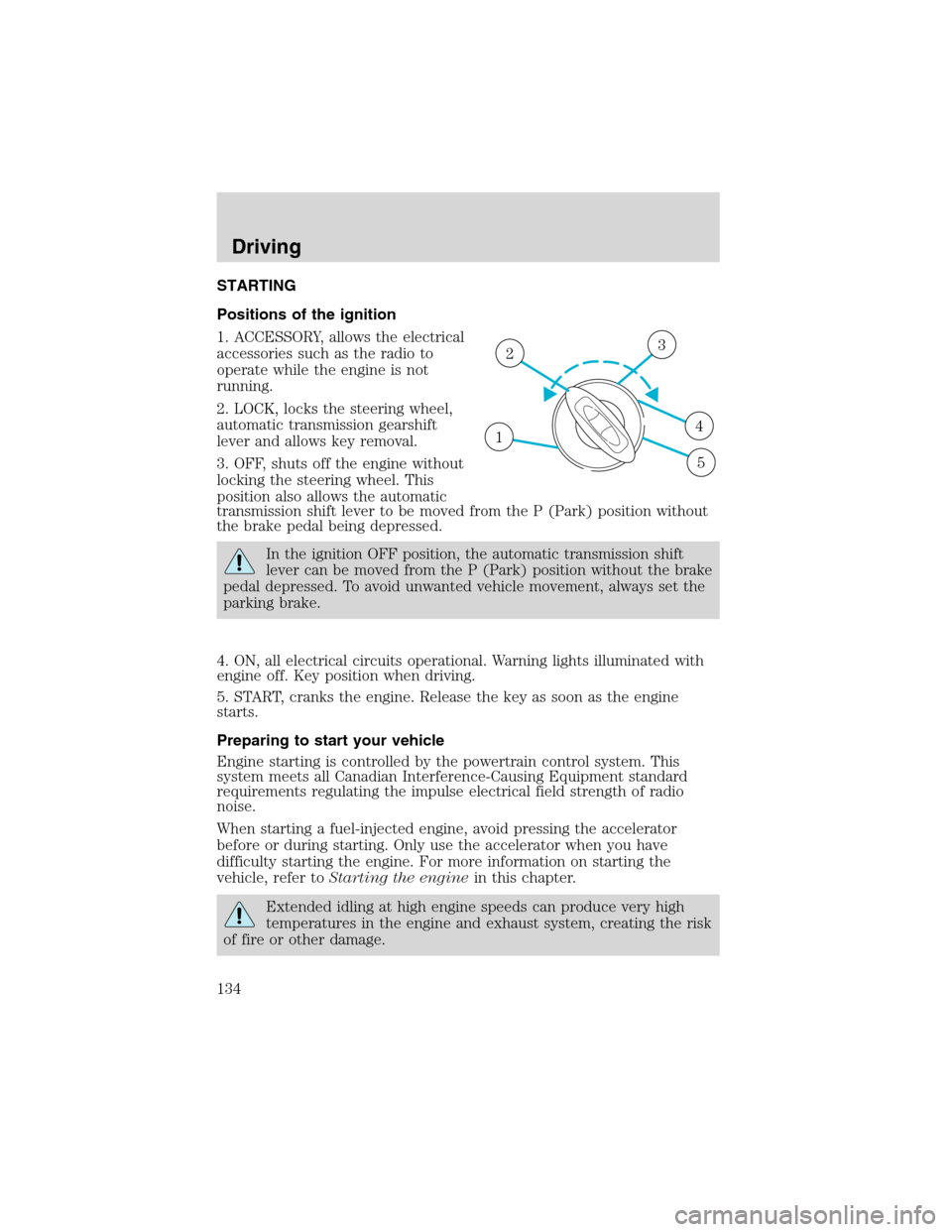
STARTING
Positions of the ignition
1. ACCESSORY, allows the electrical
accessories such as the radio to
operate while the engine is not
running.
2. LOCK, locks the steering wheel,
automatic transmission gearshift
lever and allows key removal.
3. OFF, shuts off the engine without
locking the steering wheel. This
position also allows the automatic
transmission shift lever to be moved from the P (Park) position without
the brake pedal being depressed.
In the ignition OFF position, the automatic transmission shift
lever can be moved from the P (Park) position without the brake
pedal depressed. To avoid unwanted vehicle movement, always set the
parking brake.
4. ON, all electrical circuits operational. Warning lights illuminated with
engine off. Key position when driving.
5. START, cranks the engine. Release the key as soon as the engine
starts.
Preparing to start your vehicle
Engine starting is controlled by the powertrain control system. This
system meets all Canadian Interference-Causing Equipment standard
requirements regulating the impulse electrical field strength of radio
noise.
When starting a fuel-injected engine, avoid pressing the accelerator
before or during starting. Only use the accelerator when you have
difficulty starting the engine. For more information on starting the
vehicle, refer toStarting the enginein this chapter.
Extended idling at high engine speeds can produce very high
temperatures in the engine and exhaust system, creating the risk
of fire or other damage.
1
23
4
5
Driving
134
Page 199 of 240

When lifting a plastic-cased battery, excessive pressure on the
end walls could cause acid to flow through the vent caps,
resulting in personal injury and/or damage to the vehicle or battery.
Lift the battery with a battery carrier or with your hands on opposite
corners.
Keep batteries out of reach of children. Batteries contain sulfuric
acid. Avoid contact with skin, eyes or clothing. Shield your eyes
when working near the battery to protect against possible splashing of
acid solution. In case of acid contact with skin or eyes, flush
immediately with water for a minimum of 15 minutes and get prompt
medical attention. If acid is swallowed, call a physician immediately.
Battery posts, terminals and related accessories contain lead and
lead compounds.Wash hands after handling.
Because your vehicle’s engine is electronically controlled by a computer,
some control conditions are maintained by power from the battery. When
the battery is disconnected or a new battery is installed, the engine must
relearn its idle and fuel trim strategy for optimum driveability and
performance. To begin this process:
1. With the vehicle at a complete stop, set the parking brake.
2. Put the gearshift in P (Park), turn off all accessories and start the
engine.
3. Run the engine until it reaches normal operating temperature.
4. Allow the engine to idle for at least one minute.
5. Turn the A/C on and allow the engine to idle for at least one minute.
6. Release the parking brake. With your foot on the brake pedal and with
the A/C on, put the vehicle in D (Drive) and allow the engine to idle for
at least one minute.
7. Drive the vehicle to complete the relearning process.
•The vehicle may need to be driven 16 km (10 miles) or more to
relearn the idle and fuel trim strategy.
•If you do not allow the engine to relearn its idle trim, the idle
quality of your vehicle may be adversely affected until the idle
trim is eventually relearned.
If the battery has been disconnected or a new battery has been installed,
the clock and radio settings must be reset once the battery is
reconnected.
Maintenance and Specifications
199
Page 234 of 240
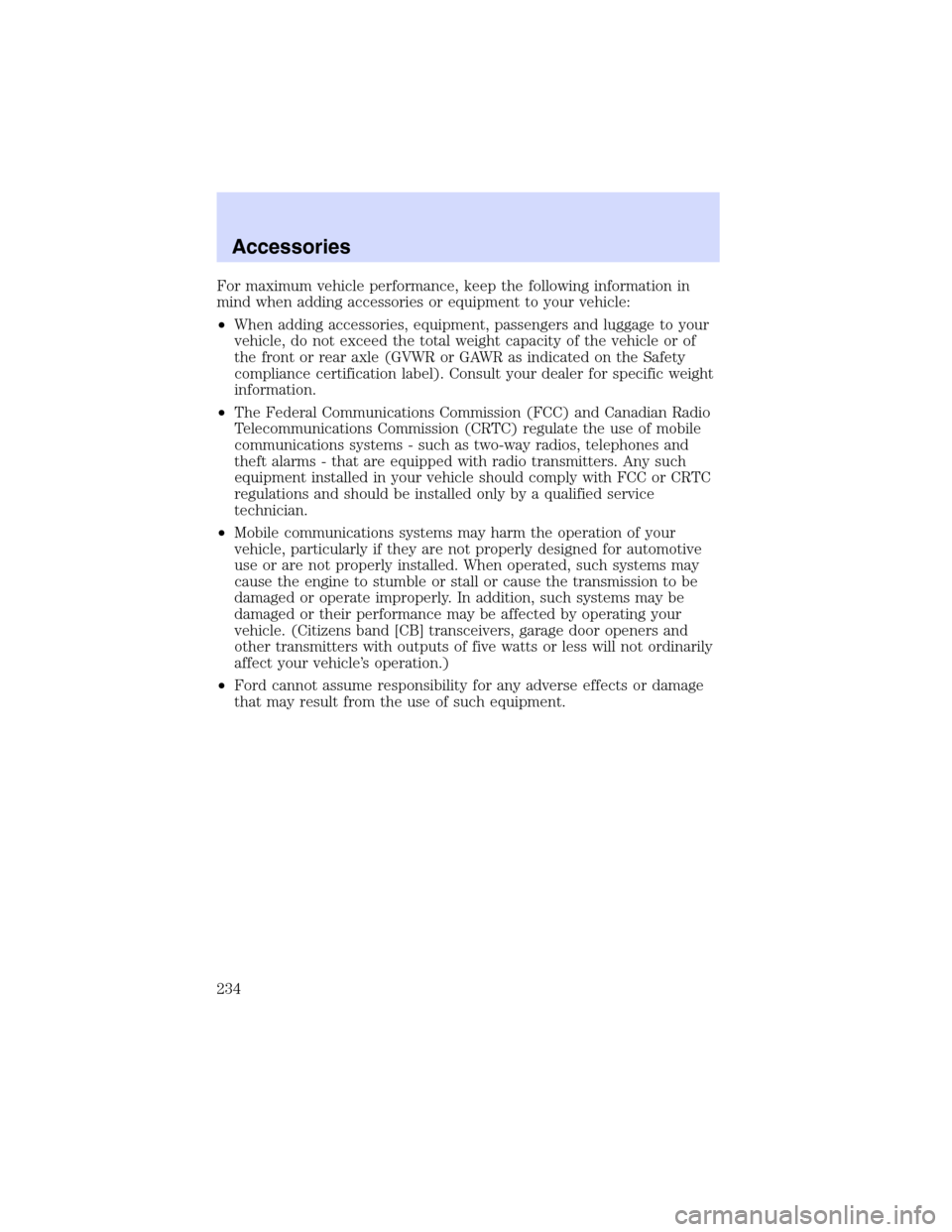
For maximum vehicle performance, keep the following information in
mind when adding accessories or equipment to your vehicle:
•When adding accessories, equipment, passengers and luggage to your
vehicle, do not exceed the total weight capacity of the vehicle or of
the front or rear axle (GVWR or GAWR as indicated on the Safety
compliance certification label). Consult your dealer for specific weight
information.
•The Federal Communications Commission (FCC) and Canadian Radio
Telecommunications Commission (CRTC) regulate the use of mobile
communications systems - such as two-way radios, telephones and
theft alarms - that are equipped with radio transmitters. Any such
equipment installed in your vehicle should comply with FCC or CRTC
regulations and should be installed only by a qualified service
technician.
•Mobile communications systems may harm the operation of your
vehicle, particularly if they are not properly designed for automotive
use or are not properly installed. When operated, such systems may
cause the engine to stumble or stall or cause the transmission to be
damaged or operate improperly. In addition, such systems may be
damaged or their performance may be affected by operating your
vehicle. (Citizens band [CB] transceivers, garage door openers and
other transmitters with outputs of five watts or less will not ordinarily
affect your vehicle’s operation.)
•Ford cannot assume responsibility for any adverse effects or damage
that may result from the use of such equipment.
Accessories
234
Page 235 of 240

A
Accessory delay ..........................45
Air bag supplemental restraint
system ..............................90–91, 94
and child safety seats ..............92
description ..........................91, 94
disposal ......................................96
driver air bag ................90, 93, 95
indicator light ...........................93
operation .......................90, 93, 95
passenger air bag .........90, 93, 95
side air bag ................................94
Air cleaner filter .......................180
Antifreeze
(see Engine coolant) ................159
Anti-lock brake system
(see Brakes) ..............................111
Anti-theft system ........................69
arming the system ....................69
disarming a triggered system ..69
Audio system (see Radio) ...15, 17
Automatic transaxle
fluid, adding ............................174
fluid, checking ........................174
fluid, refill capacities ..............181
fluid, specification ..................185
Automatic transmission
driving an automatic
overdrive .................................116
Auxiliary power point .................44
Axle
lubricant specifications ..........183
B
Battery .......................................157
acid, treating emergencies .....157
jumping a disabled battery ....135maintenance-free ....................157
replacement, specifications ...180
servicing ..................................157
BeltMinder ...................................85
Brakes ........................................110
anti-lock ...................................111
anti-lock brake system (ABS)
warning light ...........................111
fluid, checking and adding ....174
fluid, refill capacities ..............181
fluid, specifications .........183, 185
lubricant specifications ..183, 185
parking ....................................112
shift interlock ..........................113
Bulbs ............................................31
C
Capacities for refilling fluids ....181
Cargo area shade ........................56
Cargo cover .................................55
Cargo net .....................................55
CD changer .................................19
CD-single premium ...............15, 17
Cell phone use ............................52
Cellular telephone (see your
Cellular Phone Guide) ................52
Certification Label ....................187
Changing a tire .........................131
Child safety restraints ................97
child safety belts ......................97
Child safety seats ........................99
attaching with tether straps ..103
in front seat ............................100
in rear seat ......................100, 103
Cleaning your vehicle
engine compartment ..............144
Index
235
Page 238 of 240

Lane change indicator
(see Turn signal) ........................29
Liftgate ........................................54
Lights, warning and indicator ....10
anti-lock brakes (ABS) ..........111
speed control ............................51
Load limits .................................118
GAWR ......................................118
GVWR ......................................118
trailer towing ..........................118
Locks
childproof ..................................58
doors ..........................................58
Lubricant specifications ...183, 185
Lumbar support, seats ...............72
M
Mirrors .........................................44
automatic dimming rearview
mirror ........................................45
heated ........................................48
side view mirrors (power) .......47
Moon roof ....................................51
Motorcraft parts ................168, 180
O
Octane rating ............................167
Oil (see Engine oil) ..................154
Overdrive ...................................114
P
Parking brake ............................112
Parts (see Motorcraft parts) ....180
Pedals (see Power adjustable
foot pedals) .................................48Power adjustable foot pedals .....48
Power distribution box
(see Fuses) ...............................129
Power door locks ........................58
Power point .................................44
Power steering ..........................113
fluid, checking and adding ....173
fluid, refill capacity ................181
fluid, specifications .........183, 185
Power Windows ...........................44
R
Radio ......................................15, 17
Rear window defroster ...............25
Relays ................................125, 131
Remote entry system
illuminated entry ......................62
locking/unlocking doors ...........58
opening the trunk .....................61
Roof rack .....................................57
S
Safety belts (see Safety
restraints) ..................75, 77–80, 82
Safety restraints ..............75, 77–83
belt minder ...............................85
cleaning the safety belts ..........89
extension assembly ..................88
for adults .............................78–80
for children .........................96–97
lap belt ......................................82
warning light and chime ....84–85
Safety seats for children ............99
Seat belts
(see Safety restraints) ...............75
Seats ............................................71
Index
238